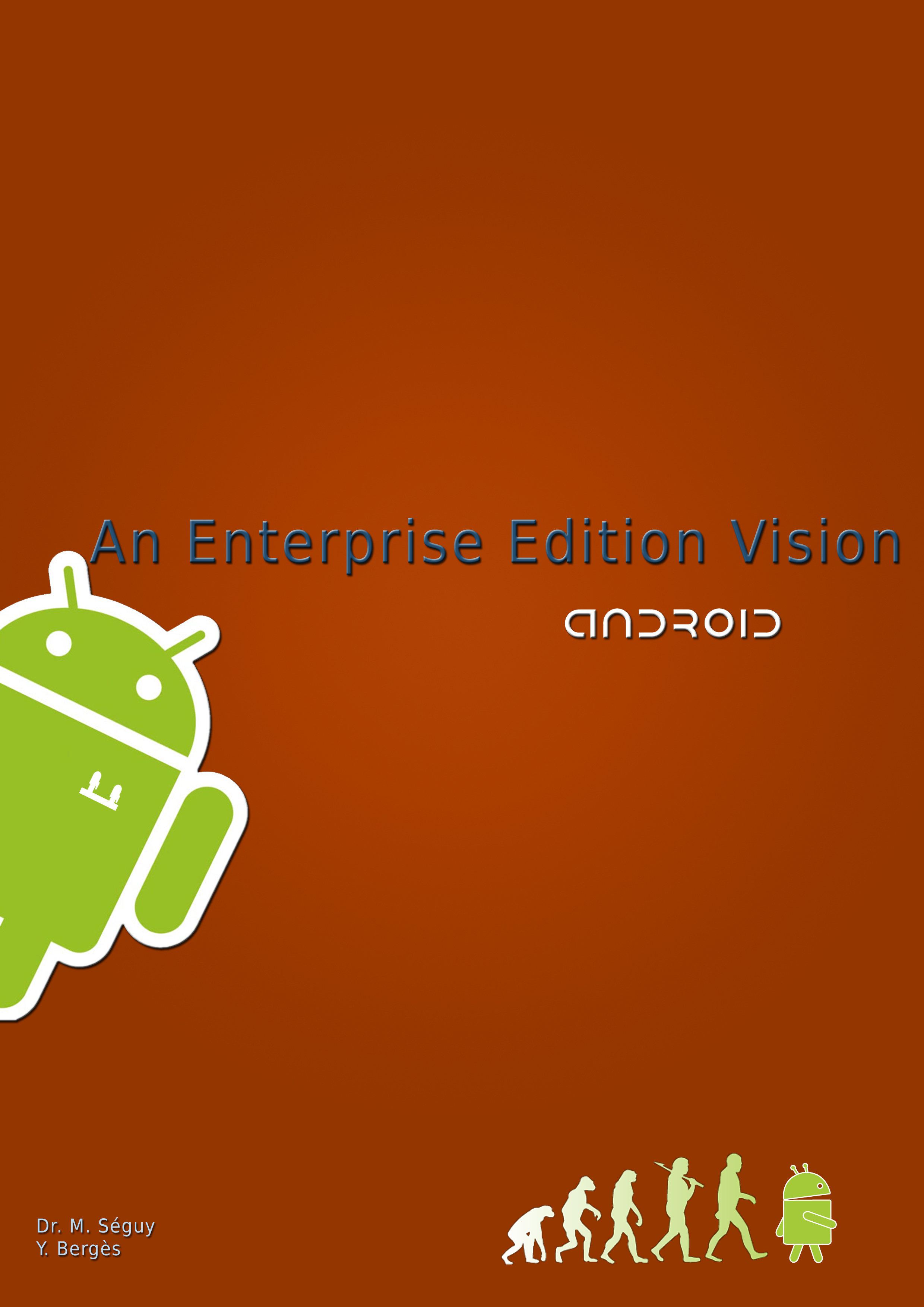
Android, An Enterprise Edition Vision
Author : Mathias Seguy
Co-author : Yannick banks
Number of pages: 96 pages
Release date 15/04/2011
Posted by http://com3elles.com/android2ee-dev
Original title: Android, An Enterprise Edition Vision. French Edition.
ISBN: 979-10-90388-02-4
Copyright © 2011 by Mathias Séguy
objectives of the book
The new operating system by Google for mobile phones and the new tablets is there. Its reputation is solid, it invades the world of telephony, it is open and offers development tools Java programmers worldwide. It opens the doors of mobile development for all developers objects with minimal cost to the rise in competence. One question arises: are you ready to implement these projects in business?
The objective of this book is very clear: what are the considerations to have when you develop an Android app as a computing professional. What is the test strategy to use? How to sign his application? How to deploy it? How to set up the management of the application lifecycle? How to implement integration continues?
This book focuses its reflection on two things that are essential:
- the know-how
- knowledge design
Concerning the know-how, it is acquired through projects Android whose code is
- purified of any functional considerations,
- extremely accurate (a project for a combo-box, a project for a web kit, a project for...) which explains that the concept associated with the example,.
- very commented and very clear.
A paragraph explains key points of understanding, the code ends the detailed explanation of the concept. This know-how will allow you to put in place all the problems that arise to you.
Concerning knowledge - design, this book explains the key points of the structuring of an Android project. Introduces the elements that form the cornerstone of your project and shows you how to build an application that adheres to these principles and take part in the most efficient way possible. Each of these concepts is highlighted by an Android project whose code has unique aims to present as clearly as possible that concept said.
On reading this book, it seems more reasonable to perform a first quick read, without dwelling on each concept, so as to have a global vision on the various considerations to have when we put in place an Android project. Then the reader refer to the specific chapters that interests him and it wishes to put the concept into practice
content
This book is divided into four distinct parts.
A chapter of this book is devoted to testing strategy to be implemented. Indeed, for Android projects, it is a complex issue in view of the diversity of devices and versions of operating systems.
A second chapter explains how to build your application and deploy it. The construction and deployment of the application are also specific to the Android apps and it is necessary to know and understand the steps to follow. The KeyStore is a key point of understanding of this process.
Then a long chapter is devoted to the implementation of the management of the lifecycle of the application using Maven. This management will bring to your project structure, serenity, and maintainability. But the establishment of Maven on an Android project is subtle. The objective of this paper is to present all of the little details to put in place so that your compilations, your tests and your deployments are happening in all serenity. This book will present the problems encountered and their solutions to achieve your goals without losing your time or your cold blood.
Finally, the last chapter focuses instead using Hudson continuous integration and automation of the portion of your tests on a set of different Android emulators
hearing
This book is intended for several types of different drives that have to charge all or part of the management of a project Android (Project Manager, technical manager, architect, developer experienced).
The objective of this book is the establishment of the development environment, in the broad sense, it is important that those who have the charge take knowledge of the thousand and one pitfalls they will encounter. Indeed, arrive at the test automation and build on a continuous integration for your project server Android is a path full of pitfalls for which it is better to have a guide.
This book will be your most comprehensive and most detailed guide.
summary
| Android a quick race 1 introduction 1.1 hearing of this book 1.2 content of this book 1.3 structure of this book 1.4 convention 1.5 your workspace 1.6 codes sources and examples Life cycle of an Android project 2. install the workspace 2.1 downloads 2.2 setting up Eclipse 3. test your application 3.1 testing devices your application targets 3.2 implementation of the test project 3.3 test activity 3.4 test a ContentProvider 3.5 test a service 3.6 Monkey and MonkeyRunner 3.7 Maven and Hudson to automate tests 4. Add the Jars to your application 5 build and deploy your application 5.1 sign his application 5.2 deploying his application 5.3 retrieve his key for MapView 6 Maven-Continuous Integration 6.1 Maven 6.2 synthesis Android-Maven: the ultimate Android Pom 6.3 Hudson or the test automation Comprehensive table of contents Index Bibliography 7 books 8 internet reference:
|
6 8 8 9 9 10 10 10 11 11 11 12 14 15 16 16 21 25 26 28 28 28 29 30 31 32 32 60 74 88 93 94 94 94 |
note
This book is the second part of the book "Android, A Complete race, From Basics to Enterprise Edition". It is dedicated to the management of the lifecycle of Android apps:
- Implementation of tests,
- Implementation of construction and deployment,
- Setting up Maven for the management of the lifecycle of the application,
- Implementation of the integration continues.
This book answers to the problems of development in business application Android.


